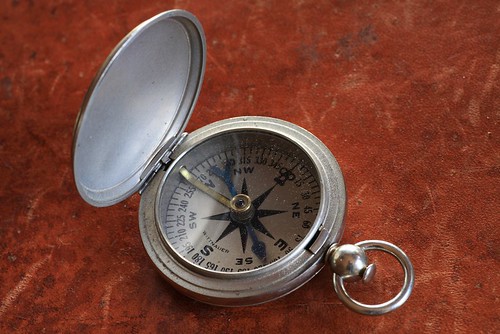Vintage pocket compass

I admit to a bit of an obsession with always being aware of cardinal directions—even in the briefest and most inconsequential of circumstances, such as while transiting between gates in a strange airport. I have a good sense of direction and can remain oriented through multiple turns in unfamiliar terrain (such as, for example, during a recent densely overcast day in downtown Brussels), but I need a base map in my head to start with, and I’m not deluded enough to think I can instinctively tell which way is north in such conditions. In fact, my first guess in Brussels was just about 180 degrees off—oops.
Meet my friend, the pocket compass. It’s a WWII-vintage Wittnauer with a jeweled flat needle, a push-button lid and needle lock on its nickel case, and a ring in case I ever want to attach a fancy silver chain to it (in case I ever start wearing a waistcoat while traveling). There’s nothing elaborate about it—it pretty much points toward magnetic north, period.
I know what many of you are thinking: An iPhone (or, I imagine, any smartphone) can do exactly the same thing with a free app. Technically, you’re right, but trust me, it’s not the same.
First, I can deploy and check this compass in a couple of seconds, far more quickly than the slide-to-unlock and multiple-step sequence of the iPhone. Plus, if one employs the iPhone compass one appears to be just another dullard staring mindlessly at one’s iPhone. Flip open the Wittnauer on a foreign city street, and complete strangers (at least, those not staring at their iPhones) stop and inquire admiringly of it, then go on to offer detailed directions and/or tips on where to go and what to see. This happened to me on the supposedly aloof streets of New York City. Twice.
The Wittnauer company dates from 1890, when Albert Wittnauer immigrated to the U.S. from Switzerland and opened a watchmaking shop with his brothers. The U.S. Navy adopted the company’s precision timepieces for early aviation tests, and in 1941 (after merging with the Longines company in 1936) Wittnauer won a contract to produce pocket compasses for the military—mostly to be included in aircraft survival kits. I’ve yet to determine how many nearly identical compasses the company produced for that contract, but it must have been a zillion, because they’re still easy to find in perfect working order. Some are stamped “U.S.” on the outside of the case; others (mine included) are not—it seems random. You can buy decent examples for around $40, or spend $150 for a mint example in its original pouch and box.
If that seems steep for a simple seven-decade-old instrument, just remember that your iPhone won’t be worth $40 in five years. If you’re like me, I’m willing to bet you’ll soon be loath to leave the house without that reassuring lump in your pocket.

An excellent source for pocket compass history is Kornelia Takacs's book Compass Chronicles. She also sells selected vintage pieces (including the superb example above) on her site, here.
Two correspondents have mentioned the exquisite Brunton Pocket transit. I'm lucky enough to own the vintage model once owned by my old scientific illustration professor:

It's bulky, but superbly accurate, and capable of measuring slip faces on dunes and a host of other angles. A true classic.
